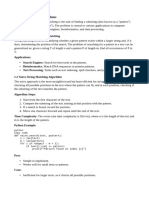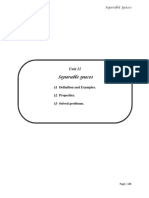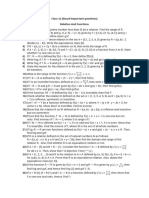String Matching Algorithms: 1 Brute Force
Uploaded by
Aarushi RaiString Matching Algorithms: 1 Brute Force
Uploaded by
Aarushi RaiCS61B Summer 2006 Instructor: Erin Korber Lecture 28: 14 Aug.
String Matching Algorithms
The problem of matching patterns in strings is central to database and text processing applications. The problem will be specied as: given an input text string t of length n, and a pattern string p of length m, nd the rst (or all) instances of the pattern in the text. Well refer to the ith character of a string s as s[i] (this syntax makes a lot of sense if you think of a string as an array of characters).
Brute force
The simplest algorithm for string matching is a brute force algorithm, where we simply try to match the rst character of the pattern with the rst character of the text, and if we succeed, try to match the second character, and so on; if we hit a failure point, slide the pattern over one character and try again. When we nd a match, return its starting location. Java code for the brute force method: for (int i = 0; i < n-m; i++) { int j = 0; while (j < m && t[i+j] == p[j]) { j++; } if (j == m) return i; } System.out.println(No match found); return -1; The outer loop is executed at most n-m+1 times, and the inner loop m times, for each iteration of the outer loop. Therefore, the running time of this algorithm is in O(nm).
Boyer-Moore
On rst glance, one might think that it is necessary to examine every character in t in order to locate p as a substring. However, this is not always necessary, as we will see in the Boyer-Moore algorithm. The one caveat for this algorithm is that it works only when the alphabet (set of possible elements of strings) is of a xed nite size. However, given that this is the case in the vast majority of applications, the Boyer-Moore algorithm is often ideal. As we will see, it works fastest when the alphabet is not too large and the pattern is fairly long (i.e. not many orders of magnitude shorter than the input). The key to not examining every character in the text is to use information learned in failed match attempts to decide what to do next. This is done with the use of precomputed tables, as we will see shortly. Perhaps the most suprising feature of this algorithm is that its checks to see if we have a successful match of p at a particular location in t work backwards. So if were checking to see if we have a match starting at t[i], we start by checking to see if p[m-1] matches t[i+m-1], and so on. The reason for this backwards approach is so we can make more progress in case the attempted match fails. For example, suppose we are trying to match the pattern ABCDE at position i of the input t. but at t[i+4], we nd the character X. X doesnt appear anywhere in ABCDE, so we can skip ahead and start looking for a match at t[i+5], since we know that the X prevents a match from occuring any earlier. In order to get the information that we need out of each failed match, the algorithm pre-processes the input pattern p and generates tables (sometimes called jump tables, since they indicate how far ahead in the text to jump). One table calculates how many positions to slide ahead in t based on the character that caused the match attempt to fail, and the other makes a similar calculation based on how many characters were matched successfully before the match attempt failed. The rst table is easy to calculate: Start at the last character of the search string with a count of 0, and move towards the rst character; each time you move left, increment the count by 1, and if the character you are on is not in the table already, add it along with the current count (so, e.g., you could use a hash table with characters as keys and the shifts that you are calculating as values). All other characters (those not appearing in p) receive a count equal to the length of the search string. (Here we see why a xed nite alphabet is essential.)
For example, for the search string ABCABDAB, this shift table is: Character Shift B 0 A 1 D 2 C 5 all other chars 8 The second table is slightly more dicult to calculate: for each value of i less than m, we must rst calculate the pattern consisting of the last i characters of the search string, preceded by a mis-match for the character before it; then we must nd the least number of characters that partial pattern can be shifted left before the two patterns match. This table is how we account for the possible repetitions within the search string. For example, for the search string ABCABDAB, the skip table is: i Pattern Shift 0 B 1 AB 8 1 2 DAB 3 3 BDAB 6 4 ABDAB 6 5 CABDAB 6 BCABDAB 6 6 7 ABCABDAB 6 Here is some pseudocode for this algorithm, supposing that the preprocessing to generate the tables has already been done. public int BoyerMoore(String t, String p) { int n = t.length(); int m = p.length(); int i = 0; while (i <= n - m) { int pos = m - 1; while(p[pos] == t[i+pos]) { if(pos == 0) { return i; } pos--; } i += max (skip((m-1)-pos) , pos - ((m-1) - shift(t[pos+i])) ) } 3
print(pattern not found); return -1; } The preprocessing to generate the tables takes (m + ) time, where is the size of the alphabet (one pass through p, plus adding an entry for each other char in the alphabet), and () space. We could reduce these both to (m), but at the expense of the constant- time access that we enjoy with the current implementation (since it would then take m time to search for a character not in the table). The best and average-case performance of this algorithm is O(n/m) (since only 1, or some small constant number out of every m characters of t needs to be checked). So, somewhat counter-intuitively, the longer that p is, the faster we will likely be able to nd it. The worst-case performance of the algorithm is approximately O(nm). This worst case occurs when t consists of many repetitions of a single character, and p consists of m 1 repetitions of that character, preceded by a single instance of a dierent character. In this scenario, the algorithm must check n m + 1 dierent osets in the text for a match, and each such check takes m comparisons, so we end up performing just as many computations as for the brute-force method. In practice, in typical string-matching applications, where the alphabet is large relative to the pattern size, and long repetitions of a single character or a short pattern of characters is not likely, Boyer-Moore performs very well.
Karp-Rabin
The Karp-Rabin algorithm searches for a pattern in a text by hashing. So we preprocess p by computing its hashcode, then compare that hash code to the hash code of each substring in t. If we nd a match in the hash codes, we go ahead and check to make sure the strings actually match (in case of collisions). Code for the algorithm:
public int KarpRabin(String t, String p) { int n = t.length(); int m = p.length(); int hpatt = hash(p); int htxt = hash(t[0..m-1]); for(int i = 0; i < n; i++) { if (htxt == hpatt) { if (t[i..i+m-1] == p) { return i; } htxt = hash(t[i+1..i+m]); } } System.out.println(not found!); return -1; } For eciency, we want to be able to quickly compute hash(t[j+1...j+m]) from hash(t[j...j+m-1]) and t[j+m] (instead of naively computing the hash from scratch for every substring of t - this would take O(m) time, and since it is done on each loop, we would have total time of O(mn)). Hash functions for which we can compute in this more ecient way are called rolling hashes. The best-case and average-case time for this algorithm is in O(m + n) (m time to compute hash(p) and n iterations through the loop). However, the worse case time is in O(mn), which occurs when we have the maximum number of collisions - every time through the loop, we nd that the hashes match, but the strings dont. With a good hashing function, this is unlikely. Karp-Rabin is inferior for single pattern searching to many other options because of its slow worst-case behavior. However, it is excellent for multiple pattern search. If we wish to nd one of some large number, say k, xedlength patterns in a text, we can make a small modication that uses a hashtable or other set to check if the hash of a given substring of t belongs to the set of hashes of the patterns we are looking for. Instead of computing one pattern hash value hpatt, we compute k of them and insert them into a hashtable or other quick lookup structure. Then, instead of checking to see if htxt == hpatt, we check to see if htxt is in the table we built. In this way, we can nd one of k patterns in O(km + n) time (km for hashing the patterns, n for searching).
You might also like
- Trings and Attern Atching: - Brute Force, Rabin-Karp, Knuth-Morris-Pratt - Regular ExpressionsNo ratings yetTrings and Attern Atching: - Brute Force, Rabin-Karp, Knuth-Morris-Pratt - Regular Expressions21 pages
- Lecture Notes On Pattern Matching AlgorithmsNo ratings yetLecture Notes On Pattern Matching Algorithms16 pages
- Rabin Karp Algorithm of Pattern Matching (Goutam Padhy)No ratings yetRabin Karp Algorithm of Pattern Matching (Goutam Padhy)15 pages
- String Matching Chapter 12 Goodrich NepNo ratings yetString Matching Chapter 12 Goodrich Nep43 pages
- Rabin-Karp String Matching Algorithm: Presented By: Marish Kr. GuptaNo ratings yetRabin-Karp String Matching Algorithm: Presented By: Marish Kr. Gupta18 pages
- AOA Module 6 - String of Algorithms - Aeraxia - inNo ratings yetAOA Module 6 - String of Algorithms - Aeraxia - in26 pages
- Lecture Notes On Pattern Matching AlgorithmsNo ratings yetLecture Notes On Pattern Matching Algorithms16 pages
- Design and Analysis of Algorithms: Dr. Sobia ArshadNo ratings yetDesign and Analysis of Algorithms: Dr. Sobia Arshad43 pages
- Mathematics Paper For Class 10 by SarthakNo ratings yetMathematics Paper For Class 10 by Sarthak2 pages
- Tools for PDE Pseudodifferential Operators Paradifferential Operators and Layer Potentials Michael E. Taylor - Download the ebook and explore the most detailed content100% (1)Tools for PDE Pseudodifferential Operators Paradifferential Operators and Layer Potentials Michael E. Taylor - Download the ebook and explore the most detailed content59 pages
- David Tong Lecture Notes - Vector CalculusNo ratings yetDavid Tong Lecture Notes - Vector Calculus130 pages
- Continuous Newton's Method For Power Flow AnalysisNo ratings yetContinuous Newton's Method For Power Flow Analysis8 pages
- Class 12 Relation and Functions Important Questions For Board Exam.No ratings yetClass 12 Relation and Functions Important Questions For Board Exam.2 pages
- 1.3 The Integral Test and Estimates of SumsNo ratings yet1.3 The Integral Test and Estimates of Sums7 pages
- Instant Ebooks Textbook (Ebook PDF) Mathematical Ideas 13th Edition by Charles D. Miller Download All Chapters100% (2)Instant Ebooks Textbook (Ebook PDF) Mathematical Ideas 13th Edition by Charles D. Miller Download All Chapters41 pages
- Second Semester Mat-C-415: Numerical ComputationsNo ratings yetSecond Semester Mat-C-415: Numerical Computations1 page
- 4-SCATTERING MATRIX-15-Jul-2019Material - I - 15-Jul-2019 - 7 - SparametersNo ratings yet4-SCATTERING MATRIX-15-Jul-2019Material - I - 15-Jul-2019 - 7 - Sparameters12 pages
- Math 23 Paced Syllabus (2nd Sem 2023-2024)No ratings yetMath 23 Paced Syllabus (2nd Sem 2023-2024)2 pages
- Sensitivity Analysis of Linear ProgrammingNo ratings yetSensitivity Analysis of Linear Programming52 pages
- Algebra: MTH-376: 1. Introduction To GroupsNo ratings yetAlgebra: MTH-376: 1. Introduction To Groups23 pages
- Trings and Attern Atching: - Brute Force, Rabin-Karp, Knuth-Morris-Pratt - Regular ExpressionsTrings and Attern Atching: - Brute Force, Rabin-Karp, Knuth-Morris-Pratt - Regular Expressions
- Rabin Karp Algorithm of Pattern Matching (Goutam Padhy)Rabin Karp Algorithm of Pattern Matching (Goutam Padhy)
- Rabin-Karp String Matching Algorithm: Presented By: Marish Kr. GuptaRabin-Karp String Matching Algorithm: Presented By: Marish Kr. Gupta
- AOA Module 6 - String of Algorithms - Aeraxia - inAOA Module 6 - String of Algorithms - Aeraxia - in
- Design and Analysis of Algorithms: Dr. Sobia ArshadDesign and Analysis of Algorithms: Dr. Sobia Arshad
- Tools for PDE Pseudodifferential Operators Paradifferential Operators and Layer Potentials Michael E. Taylor - Download the ebook and explore the most detailed contentTools for PDE Pseudodifferential Operators Paradifferential Operators and Layer Potentials Michael E. Taylor - Download the ebook and explore the most detailed content
- Continuous Newton's Method For Power Flow AnalysisContinuous Newton's Method For Power Flow Analysis
- Class 12 Relation and Functions Important Questions For Board Exam.Class 12 Relation and Functions Important Questions For Board Exam.
- Instant Ebooks Textbook (Ebook PDF) Mathematical Ideas 13th Edition by Charles D. Miller Download All ChaptersInstant Ebooks Textbook (Ebook PDF) Mathematical Ideas 13th Edition by Charles D. Miller Download All Chapters
- 4-SCATTERING MATRIX-15-Jul-2019Material - I - 15-Jul-2019 - 7 - Sparameters4-SCATTERING MATRIX-15-Jul-2019Material - I - 15-Jul-2019 - 7 - Sparameters























































































